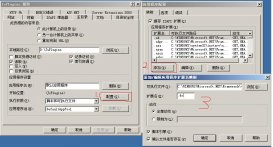前言
.net core 出来有一时间了,这段时间也一直在做技术准备,目前想做一个单点登录(SSO)系统,在这之前用.net时我用习惯了machineKey ,也顺手在.net core 中尝试了一上,结果发现不好使了,也不起作用,于是开始了网上学习。
实现方法
功夫不负有心人,网上高人还是多,在github.com上面ISSUES中也有人在讨论此问题,于是找到代码尝试,结果实现了。
直接上代码,我们需要先封装一个XmlRepository,Key的格式如下:
|
1
2
3
4
5
6
7
8
9
10
11
12
13
14
15
16
|
<?xml version="1.0" encoding="utf-8"?><key id="cbb8a41a-9ca4-4a79-a1de-d39c4e307d75" version="1"> <creationDate>2016-07-23T10:09:49.1888876Z</creationDate> <activationDate>2016-07-23T10:09:49.1388521Z</activationDate> <expirationDate>2116-10-21T10:09:49.1388521Z</expirationDate> <descriptor deserializerType="Microsoft.AspNetCore.DataProtection.AuthenticatedEncryption.ConfigurationModel.AuthenticatedEncryptorDescriptorDeserializer, Microsoft.AspNetCore.DataProtection, Version=1.1.0.0, Culture=neutral, PublicKeyToken=adb9793829ddae60"> <descriptor> <encryption algorithm="AES_256_CBC" /> <validation algorithm="HMACSHA256" /> <masterKey p4:requiresEncryption="true" xmlns:p4="http://schemas.asp.net/2015/03/dataProtection"> <!-- Warning: the key below is in an unencrypted form. --> <value>WYgZNh/3dOKRYJ1OAhVqs56pWPMHei15Uj44DPLWbYUiCpNVEBwqDfYAUq/4jBKYrNoUbaRkGY5o/NZ6a2NTwA==</value> </masterKey> </descriptor> </descriptor></key> |
XmlRepository代码:
|
1
2
3
4
5
6
7
8
9
10
11
12
13
14
15
16
17
18
19
20
21
22
23
|
public class CustomFileXmlRepository : IXmlRepository { private readonly string filePath = @"C:\keys\key.xml"; public virtual IReadOnlyCollection<XElement> GetAllElements() { return GetAllElementsCore().ToList().AsReadOnly(); } private IEnumerable<XElement> GetAllElementsCore() { yield return XElement.Load(filePath); } public virtual void StoreElement(XElement element, string friendlyName) { if (element == null) { throw new ArgumentNullException(nameof(element)); } StoreElementCore(element, friendlyName); } private void StoreElementCore(XElement element, string filename) { } } |
Startup代码:
|
1
2
3
4
5
6
7
8
9
10
11
12
13
14
15
16
17
18
19
20
21
22
23
24
25
26
27
28
29
30
31
32
33
34
35
36
37
38
39
40
41
42
43
44
45
46
47
48
49
50
51
52
53
54
55
56
57
58
59
60
61
|
public class Startup { public Startup(IHostingEnvironment env) { var builder = new ConfigurationBuilder() .SetBasePath(env.ContentRootPath) .AddJsonFile("appsettings.json", optional: true, reloadOnChange: true) .AddJsonFile($"appsettings.{env.EnvironmentName}.json", optional: true) .AddEnvironmentVariables(); Configuration = builder.Build(); } public IConfigurationRoot Configuration { get; } // This method gets called by the runtime. Use this method to add services to the container. public void ConfigureServices(IServiceCollection services) { services.AddSingleton<IXmlRepository, CustomFileXmlRepository>(); services.AddDataProtection(configure => { configure.ApplicationDiscriminator = "Htw.Web"; }); // Add framework services. services.AddMvc(); } // This method gets called by the runtime. Use this method to configure the HTTP request pipeline. public void Configure(IApplicationBuilder app, IHostingEnvironment env, ILoggerFactory loggerFactory) { loggerFactory.AddConsole(Configuration.GetSection("Logging")); loggerFactory.AddDebug(); if (env.IsDevelopment()) { app.UseDeveloperExceptionPage(); app.UseBrowserLink(); } else { app.UseExceptionHandler("/Home/Error"); } app.UseStaticFiles(); app.UseCookieAuthentication(new CookieAuthenticationOptions() { AuthenticationScheme = CookieAuthenticationDefaults.AuthenticationScheme, LoginPath = new PathString("/Account/Unauthorized/"), AccessDeniedPath = new PathString("/Account/Forbidden/"), AutomaticAuthenticate = true, AutomaticChallenge = false, CookieHttpOnly = true, CookieName = "MyCookie", ExpireTimeSpan = TimeSpan.FromHours(2),#if !DEBUG CookieDomain="h.cn",#endif DataProtectionProvider = null }); app.UseMvc(routes => { routes.MapRoute( name: "default", template: "{controller=Home}/{action=Index}/{id?}"); }); } } |
登录代码:
|
1
2
3
4
5
6
7
8
9
10
11
12
13
14
15
|
public async void Login() { if (!HttpContext.User.Identities.Any(identity => identity.IsAuthenticated)) { var user = new ClaimsPrincipal(new ClaimsIdentity(new[] { new Claim(ClaimTypes.Name, "bob") }, CookieAuthenticationDefaults.AuthenticationScheme)); await HttpContext.Authentication.SignInAsync(CookieAuthenticationDefaults.AuthenticationScheme, user); HttpContext.Response.ContentType = "text/plain"; await HttpContext.Response.WriteAsync("Hello First timer"); } else { HttpContext.Response.ContentType = "text/plain"; await HttpContext.Response.WriteAsync("Hello old timer"); } } |
注意
C:\keys\key.xml 这个文件路径可以更改,还有就是也可用共享目录或数据库来实现统一管理
到此可以登录试一下。
以上所述是小编给大家介绍的.net core 1.0 实现单点登录负载多服务器的全部叙述,希望对大家有所帮助!
原文链接:http://www.cnblogs.com/hantianwei/p/5699370.html












